
Six Abandoned Cities and Their Haunting Histories
Time is a cruel mistress, and nothing lasts forever. Eventually, even the greatest of empires and cities are doomed to crumble. Over the centuries, many once-prosperous towns have been abandoned and fallen into ruin. This can be due to warfare or natural disasters, or sometimes plain old bad luck. We’ve gathered six famous towns and cities from history which were ultimately abandoned and left to the sands of time.
1.Fabbriche di Careggine: Tuscany’s Sunken Village
Fabbriche di Careggine is located in the province of Lucca in Tuscany. It dates back to the 13th century AD but sadly has been abandoned since 1947. Why was this idyllic little Tuscan village with its beautiful 13th-century architecture discarded?
This abandoned city was left behind for the same reason sites throughout history have been abandoned: human development. In 1947, construction work on a dam on the nearby Edron River began. When it was completed, the nearby Lake Vagli was artificially flooded and the evacuation of Fabbriche di Careggine was ordered, with its residents being forced to relocate to nearby towns.
Today, Fabbriche di Careggine sits under around 9 million gallons (34 million cubic meters) of water, making it difficult to visit. Since its original flooding, the small village has been drained four times: in 1958, 1974, 1983, and 1994. The company that owns the lake, Enel, reportedly planned on emptying it once again in 2016, but the plans were put on hold.
Likewise, there was much excitement in 2021, when Enel announced plans to drain the lake again that year, but this didn’t go ahead. It seems likely that the lake will be drained again at some point in the near future, offering a glimpse into this historic abandoned city.
- 14 Stunning Pictures of Ancient Ghost Towns
- The Haunted Ruins of Khara Khoto, The Black City of Mongolia

One of several Italian abandoned cities, Fabbriche di Careggine now lies underwater the majority of the time. The lake was drained in 1994, allowing this rare photo. (Public Domain)
2.Chinguetti: An Abandoned Trade Center
Chinguetti is located in northern Mauritania on the Adrar Plateau. This location has been inhabited in some form or another for thousands of years. A city was first founded there in 777 AD, and by the 11th century had become a trading hub for a confederation of local tribes called the Sanhaja.
The city's success lay in the fact it sat at a crossroads for trade routes. Over time, the Sanhaja tribes began to interact with and then merged with the Almoravid dynasty, headed at the time by Abdallah ibn Yasin. This was a Berber Muslim dynasty with strict religious views. The city’s stark, undecorated architecture reflects these views.
Between the 11th and 13th centuries, the city saw a period of decline. It was re-founded in the 13th century as a fortified trade center for trade caravans crossing the Sahara. The fortified walls were lost centuries ago, but many of the buildings in the center of Chinguetti today are from this period.
Between the 13th and 17th centuries, the city became a religious center. Every year, thousands of Sunni pilgrims who were traveling to Mecca would gather in Chinguetti to trade, gossip, and pray before moving on.
At its peak, the city was home to around 20,000 people; today, that number is down to a few thousand. Now, rather than being a trade center, the city is largely abandoned. Those who remain make their living through tourism. The city is isolated and at 65 miles from the nearest city, Atar, hard to reach.
Conservation efforts are ongoing to save the city, but the simple fact is that unless things change, one day Chinguetti will be completely abandoned. The neighboring Sahara desert is creeping ever southward and will soon devour the city completely through desertification. Even if efforts to slow desertification by heritage experts are successful, the city will still become largely unlivable, becoming an archaeological site more than anything.
- The Ancient Ruins of Salamis, the Once Thriving Port City of Cyprus
- Ani: The Ghost City of 1001 Churches
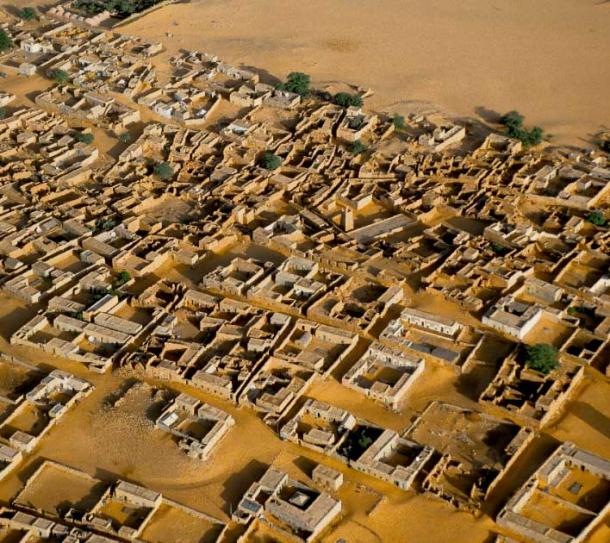
Chinguetti in Mauritania dates back to the 6th century AD, but like other abandoned cities, it has been slowly deserted. (Overflightstock / Adobe Stock)
3.Craco: A Beautiful Ghost Town
A lot of factors can lead to a town or city being abandoned. In the case of Craco, a historic ghost town and commune in Matera, Italy, it was faulty plumbing.
The area around Craco has been populated for thousands of years. Tombs found in the area date back to at least the 8th century BC, and we know that the ancient Greeks moved into the area around 540 BC after moving inland from the nearby coastal town of Metaponto. The town as it is known today, however, dates back to 1060 AD.
At that time, the land was owned by the archbishop of Tricarico, Arnaldo. He named the town Craco and its surrounding area Graculum. From the early days of the city’s founding, it had a close relationship with the church.
Over the following decades, the town quickly grew. From 1154 to 1168, it was controlled by the nobleman Eberto, and in 1179 it passed over to Roberto of Pietrapertosa. Between 1198 and 1212, the town became an important military center, with its Castle Tower acting as a jail for Lombard prisoners who had risen up against the Holy Roman Empire.
In 1276, Craco got its own university. This led to a population surge over the following centuries; the population went from 450 people in 1277 to 1718 at its peak in 1532. Around that time, four palazzi (palaces) were also developed in the town: the Palazzo Maronna, Palazzo Grossi, Palazzo Carbone, and Palazzo Simonetti.
In 1656, a dreadful plague struck, which led to hundreds dying and a drastic drop in population. More unrest came to the town in 1799, with the rise of the Parthenopean Republic, which was a short-lived semi-autonomous republic based in the Kingdom of Naples.
The republic’s proclamation led to the townspeople overthrowing the traditional Bourbon feudal system. It all only lasted a few months, after the army of Holy Faith was sent in, the town once again bowed down to the Bourbon monarchy.
Craco saw bloodshed in 1861, when the unification of Italy saw the town conquered by bands of brigands led by Carmine Crocco. Sadly, an end to civil strife didn’t mean Craco could return to prosperity. From 1892 to 1922, many people migrated out of the area to North America due to repeated poor harvests.
Craco’s abandonment began in 1963, when it had to be evacuated due to a series of landslides and many of the inhabitants moved into the nearby Craco Peschiera Valley. It seems the landslides were first brought on by leaks in the city’s aging sewer and water infrastructure.
Hopes of repopulation were dashed when the town was hit by a serious flood in 1972, which caused more damage. The Irpinia earthquake of 1980 sealed the town’s fate. Today, the city is a popular tourist attraction and filming location, with several TV shows and films being shot on location in the last couple of decades.
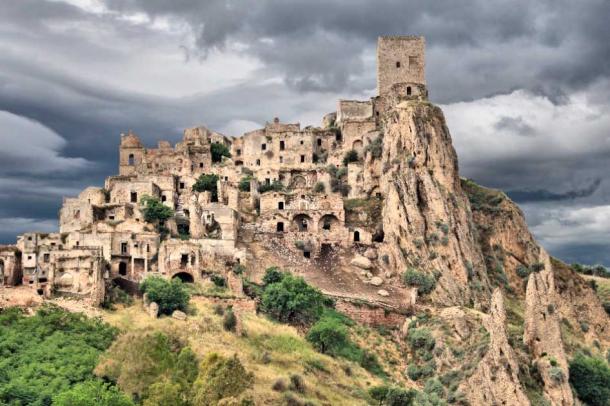
The abandoned city of Craco, Italy was motivated by a combination of factors (Tupungato / Adobe Stock)
4.Gamsutl: A Village in the Clouds
Gamsutl is located on Mount Gamsutlmeer in Dagestan, Russia, and is one of the region’s oldest settlements. The reason this village was abandoned becomes clear when one considers it sits around 4,600 feet (1,400 meters) above sea level.
Gamsutl means ‘at the foot of the khan’s fortress,’ which gives us an important clue as to the village’s history. It is believed the site was once the site of a fortress for a local khan whose name has been lost to time, and that a small community then sprung up around the structure.
The theory makes sense; the area is surrounded by natural defenses, such as uneasy cliffs and perilous slopes, which would make an attack next to impossible. It is believed the site has been inhabited for 2,000 to 5,000 years, and at its peak had 300 homes.
Surprisingly, despite the area’s harsh conditions and remoteness, Gamsutl was still a busy village well into the 20th century, with its own shops, post office, and even a hospital. Over time, however, the locals, especially the younger generations, began to move away, looking for better livelihoods elsewhere.
The town was officially abandoned in 2015, with the death of the town's last loyal resident, Abdulhalil Abdulhalilov. Today, this ancient stronghold is a ghost town; all that’s left are the rotting vestiges of 70 abandoned homes.
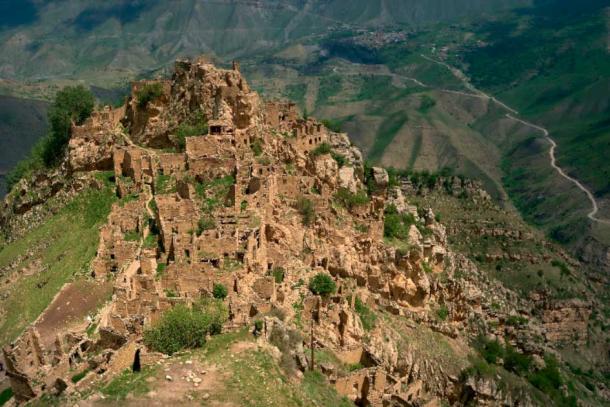
Like other abandoned cities, Gamsutl lost residents over centuries rather than all at once (Vladimir Varfolomeev / CC BY NC 2.0)
5.Suakin: Abandoned for its Neighbor
Suakin, also known as Sawakin, is a historic port city in northeastern Sudan on the Red Sea’s north coast. The city was an important trade hub for thousands of years and served some of history’s greatest empires.
It is believed Ramses III first began development on the port of Suakin in the 10th century BC. The area offered an ideal outlet to the Red Sea for both trade and exploration. During the medieval period, as Islam rose up and its followers spread through what is now Saudi Arabia, the port became a center for Africans making the pilgrimage to Mecca.
Suakin evolved throughout the medieval period. It began as a small Beja settlement but quickly began to grow after the nearby port of Badi was abandoned. Both the Crusades and repeated Mongol invasions also worked in the city’s favor by driving trade into the region.
This increased trade led to great wealth flooding into the area. Local legends tell of a king who operated out of the city. It is said he and his 360 wives lived in lavish quarters in the old part of town. The city soon became a rich, gated island port. It was a sight to behold, the buildings were made out of coral and decorated with detailed wood and stone carvings.
The city’s success led to some jealousy between it and its competitors. In 1264, the governor of Qus (an Egyptian city on the Nile) attacked Suakin, leading to the city’s ruler, As-Asba’ani, fleeing.
The Ottomans later moved into Suakin and added the port city to their empire in 1517. The city was largely allowed to govern itself, while the Ottomans restored the city’s mosques and strengthened its fortified walls. This turned out to be a poor investment. As Portuguese explorers perfected the sea route around Africa, local merchants began to abandon the town and it fell into decline. By the 18th and 19th centuries, much of the old town was in ruins.
Suakin saw one last drive during the 19th century, when it became a hub for the slave trade from eastern Africa. This was short-lived, however, and as the slave trade diminished, so did Suakin. The British Empire spent some time in Suakin during the late 19th century, but ultimately decided the new Port Sudan would be a better site for their investment.
By the 1920s, Suakin was falling apart. Shallow waters and dangerous coral meant that most trade had moved to Port Sudan. The city's once beautiful coral buildings were too expensive to maintain and fell into disrepair. Today, most of the old city is abandoned and serves only as a tourist site. In January 2018, Turkey was granted a 99-year lease on the city and the country plans to restore the city's ruined Ottoman port.
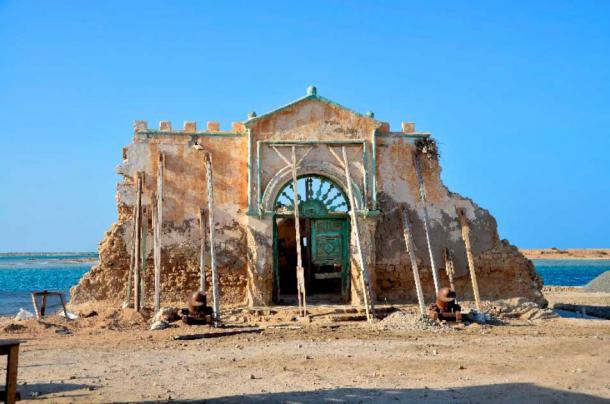
Very little remains standing in the abandoned city of Suakin, an ancient Ottoman port (Robnaw / Adobe Stock)
6.Kayakoy: An Abandoned Greek Village in Turkey
Perhaps the saddest entry on this list is Kayakoy in southwest Turkey. Once a bustling town home to 10,000 people, the town has been completely abandoned since 1922.
Kayakoy’s history goes back thousands of years. Originally known as Carmylessus in ancient Greek, its name was shortened to Lebessos and pronounced as Levissi in modern Greek.
In late antiquity, the region around Kayakoy became Christian, and then Greek Orthodox after the East-West schism with the Catholic Church in 1054 AD. From the Ottoman conquest of the region in the 14th century until the early 20th century, the people of Kayakoy lived in relative harmony with their Muslim Ottoman neighbors. For centuries, the town was a thriving and harmonious community where people of different religions lived peacefully side by side.
Sadly, this coexistence ended with the end of the Greco-Turkish War of 1919-1922, which culminated in the Treaty of Lausanne in 1923. The terms of the treaty were relatively simple; Greeks were to be expelled from Turkey and vice versa. This meant the historic town of Levissi became Karakoy, and its 6,000 Christian residents were forced to leave and abandon their homes.
In total, the exchange uprooted 200,000 Greeks and 300,000 Turks who were forced to leave their homes and relocate to a country where they knew no one and were seen as outsiders. The Muslims who came from Greece decided not to move to Karakoy, seeing it as too remote.
Over time, the once beautiful town began to fall into ruin, with an earthquake in 1957 adding insult to injury. While still abandoned today, Karakoy has seen somewhat of a resurgence in recent times as a tourist attraction.
The Turkish Ministry of Culture has given it museum status and the site is recognized by UNESCO. The release of Louis de Berniere's excellent Birds without Wings, which is set in the village during WWI and the population exchange has brought the ghost town international attention.
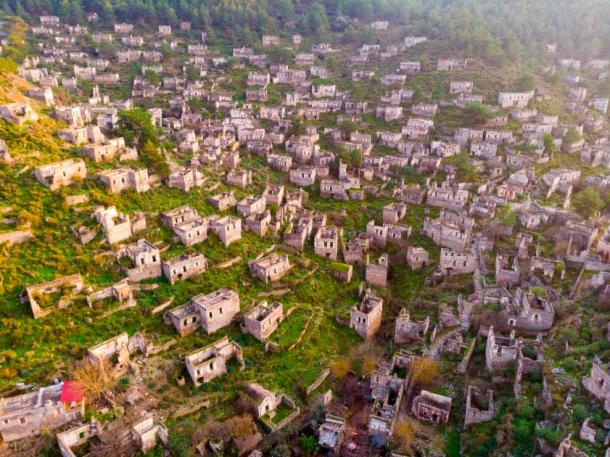
The abandoned city of Karakoy, Turkey (JackF / Adobe Stock)
Conclusion
Just because a town or city has been abandoned doesn’t mean it isn’t still important. These once-thriving places have much to teach us about those who came before us. Their histories have shaped the regions that surround them today.
Thankfully in recent times, many countries have become much better at preserving their histories. Most of the sites on this list would have once been left to rot away until nothing was left. However, thanks to the hard work of organizations like UNESCO, today the opposite is true.
These abandoned towns and cities have become important revenue makers for their home countries as tourist hotspots. Every year, thousands of tourists flood these areas to see their breathtaking views and take in their fascinating history. As they do so, they pay for the renovation and preservation of these once-thriving cities.
Top Image: These abandoned cities from across the globe are the remnants of a different era. Pictured: Aerial view of Craco, Basilicata region of Italy. Source: Pavlo Glazkov / Adobe Stock
References
Walker-Arnott, E. June 1, 2020. This sunken Italian village might be about to resurface. Time Out. Available at: https://www.timeout.com/news/this-sunken-italian-village-might-be-about-to-resurface-060120
Maglaty, J. March 2009. Endangered Site: Chinguetti, Mauritania. Smithsonian Magazine. Available at: https://www.smithsonianmag.com/travel/endangered-site-chinguetti-mauritania-54168194/
York, O. February 12, 2021. Gamsutl. Atlas Obscura. Available at: https://www.atlasobscura.com/places/gamsutl
Sawakin. July 20, 1998. Encyclopedia Britannica. Available at: https://www.britannica.com/place/Sawakin
Yalav-Heckeroth, F. December 26, 2022. The Story Behind Turkey’s Abandoned Religious Ghost Town. Culture Trip. Available at: https://theculturetrip.com/europe/turkey/articles/the-story-behind-turkeys-abandoned-religious-ghost-town/
















Comments
Interesting. The elevated sites are almost certainly all pre-Ice Age constructions, back when those regions were lush, with sea level much higher, not rocky barrens like now. You wouldn’t do all that work in a locale that doesn’t support farms/agriculture, and without a good, fresh-water source. The ones partially submerged would have been constructed (by Atlantean era survivors) early in the Ice Age, say 100k to 40k BC, when seas were lower (bigger ice caps than now).
Nobody gets paid to tell the truth.